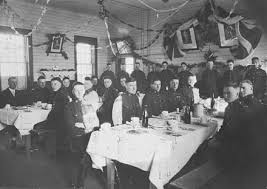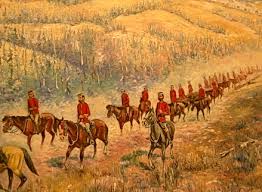HISTORY OF THE NWMP – Continued
“It seemed,” said McIntyre, “as though we were suddenly passing from winter into spring.” Soon after they came upon the first of numberless hot springs, the snow disappeared entirely, and dense vegetation took the place of the stunted bush and timber of the plains. Because of necessarily slow travel on foot the explorers were not able to determine the extent of the wonderful oasis in the midst of an arctic desolation. They found several good-sized rivers, flowing with warm water and teeming with fish, and the country was alive with bear, caribou, duck, pheasant, wild geese, and other game, and gold was found in a number of the creeks.
McIntyre was to have made a second trip into this mysterious country, but was prevented through the outbreak of war. Now that the force has been increased in numbers these exploration journeys are to be resumed, and who can say what geographical wonders will be discovered? For five hundred miles east and west and from two to three hundred miles north of the Porcupine River, there is a vast unexplored region as little known as the planet Mars.

PART THREE
As pioneers of road-making the police are of the greatest value, their latest work in this respect being the construction of a trail from Edmonton to Dawson City, a distance of nearly 2,000 miles, through the Peace River country. The difficulty of constructing this trail may be understood when it stated that three years were occupied in making it. Its principal use for some time to come will be as a road for the conveyance of prisoners from Dawson City to Edmonton, without passing through the United States territory. Yet the greatest tragedy in the history of the mounted police occurred on this trail.
While passing overland from Fort McPherson to Dawson City a patrol under Inspector Fitzgerald got lost in a blizzard. They wandered about until they died from starvation and exhaustion. One man committed suicide. The relief expedition which found the remains also recovered a diary of the leader in which the story of how they ate their dogs and then the leather of their moccasins was told. The Annals of Arctic and Antarctic exploration does not contain a more thrilling narrative of a brave man’s fight against the forces of nature than Fitzgerald’s little diary.
In carrying out their ordinary police work these daring men, in making their way across the trackless wilds of the Northland, return with valuable information as to the existence of rivers, lakes, mountains and creeks, which enables the mapmakers to fill in the blank spaces. Patrols covering a thousand miles and more have frequently to be made.
THE COPPERMINE RIVER CRIME
A recent example of hunts for murderers in the far north is here described. Some five years ago two Roman Catholic missionaries were murdered at the head of Great Bear Lake. It took some time for the news to reach the police headquarters, but early in June, 1915, Inspector LaNauze, a twenty-seven- year old officer, was dispatched to arrest two Eskimos who were suspected of the crime. Taking two constables with him, he left Regina and proceeded to Peace River Landing, Alberta, by train. From there they went down the Peace River to Lake Athabasca, then down the Slave River to Great Slave Lake, which they crossed to the mouth of the Mackenzie River. Down that stream they went to Fort Norman, at the mouth of the Bear River. Following the Bear River to Great Bear Lake, they crossed it to Dease Bay, where the party wintered in the very cabin where the priests had lived.
TBC
